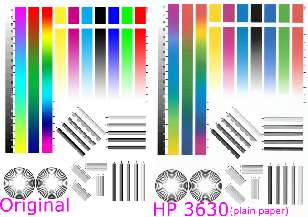Rick's b.log - 2017/07/09
You are 18.188.168.28, pleased to meet you!
Rick's b.log - 2017/07/09 |
|
| It is the 29th of April 2024 You are 18.188.168.28, pleased to meet you! |
|
mailto: blog -at- heyrick -dot- eu
And here is Taylor Swift (this picture), chosen because she was on the radio (yet another breakup song) when I went to look for a picture. This is best quality print to plain paper.
The final example is the church photo previously printed in best quality to photo paper.
Both printers have print heads built into the cartridge. Both use thermal technology to squeeze out the ink. A tiny resistor creates heat, which boils the ink, which causes it to burst out on to the paper. I've read a document that says - and I quote: "Fun Fact: The ink in a thermal print head is, for a nanosecond, close to a million degrees centigrade - hotter than the surface of the sun!". I call bull on that, the sun's surface is the cold part, at around 5800K (~5500°C) which is actually cooler than the Earth's core. At any rate, for a miniscule fraction of a second, the ink is superheated which creates a bubble which pushes the ink out on to the paper. This is why early inkjets were also called "Bubble Jet" (which is actually a Canon trademark).
The other type of print head, used by Brother and Epson, is the piezoelectric. This, like a piezo buzzer, uses current to cause a tiny shift in a material which pushes ink out.
The thing is, thermal print heads have less finesse than piezoelectric. Typically the dot size of a thermal head is larger, and you may have only one or two dot sizes, plus the heat means that only certain ink formulations are going to work. Also the repeated heating means the heads are more prone to failure and will need replacement. On the other hand, a thermal head is a lot cheaper. Therefore it makes sense for the built-in-head style printers (generally Brother and Epson) to use a piezo head, while the head-on-cartridge style printers (generally Canon and HP) will use thermal technologies.
Now, the thing is, it seems to me that the HP printers may have less control over the dot size, leading to visual patterning, especially in areas of similar shading (such as the sky). Additionally, there is no such thing as grey - grey is often synthesised using the colours. A black dot is a black dot, and as you can see from the images, the black dots can look a bit stark.
In summary? I think the HP printout is just a little starker than the Canon, and while I don't have any "best quality" photos to hand for my old Brother (I used Normal quality to save ink), I think it created better than both - but that's not a surprise as it will have used a piezo ink head for better control of the dots. Something that is noticeable is that Normal quality printing, on both, may lead to visible banding effects. After the print heads have been cleaned and aligned.
The last test is a print test page. I downloaded and printed this page to plain paper, best quality, and scanned it at 300dpi. The colours are muted because this is plain paper, and print inks rather than an RGB display.
You can also look at the original scan, as saved from the printer's WebScan at 300dpi. It is 2481×3507, 1.03MiB.
One last thing... Let's offer HP a slow handclap! Stuff in magenta are my annotations.
HP DeskJet 3630 print quality
The first example is the face of the Russian girl featured a few months back. This was printed on the Canon Pixma MG2450. I shook the printer and there was enough black to get this picture out. Entirely random choice of picture, just happened to be the first one I came to that was a picture of a person. This is best quality print to plain paper.



That said, this printer is the budget end of the scale, so we can't expect it to behave the same as an expensive model.
Original on the left, scanned print on the right.


David Pilling, 18th July 2017, 13:19
They may be using a different way of looking at temperature. Sonoluminescence comes to mind where sound waves generate tiny bubbles which appear as flashes of light as they collapse because they are so hot.Rick, 18th July 2017, 13:45
But, then, as I point out they pretty much failed to do their homework when it came to the sun's temperature so I'm inclined to think they just picked "a really big number".
| © 2017 Rick Murray |
This web page is licenced for your personal, private, non-commercial use only. No automated processing by advertising systems is permitted. RIPA notice: No consent is given for interception of page transmission. |